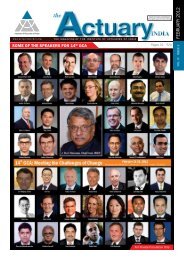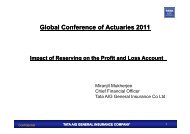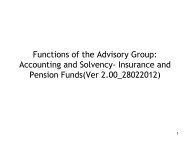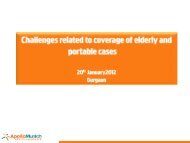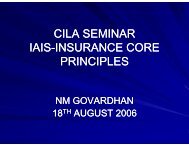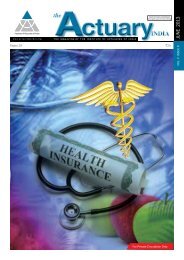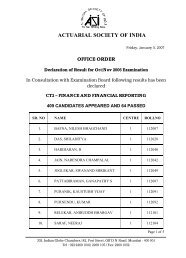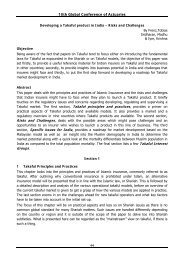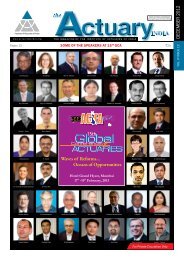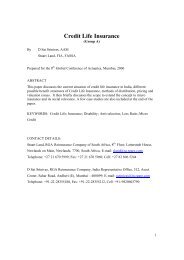Employee Benefits (IAS 19) - Actuarial Society of India
Employee Benefits (IAS 19) - Actuarial Society of India
Employee Benefits (IAS 19) - Actuarial Society of India
- No tags were found...
You also want an ePaper? Increase the reach of your titles
YUMPU automatically turns print PDFs into web optimized ePapers that Google loves.
Basic Principle <strong>of</strong> <strong>IAS</strong> <strong>19</strong>• The cost <strong>of</strong> providing employee benefitsshould be recognized in the period inwhich the benefit is earned by theemployee, rather than when it is paid orpayable.www.carajkumarradukia.com 5
<strong>IAS</strong> <strong>19</strong> – <strong>Employee</strong> <strong>Benefits</strong> -• The Standard identifies followingcategories <strong>of</strong> employee benefits to becovered– Short term employee benefits– Post-employment benefits– Other long term employee benefits– Termination benefits• It covers formal plans, state plans,constructive obligation (informal practices)www.carajkumarradukia.com 6
<strong>IAS</strong> <strong>19</strong> Applies to1. Wages and Salaries2. Compensated Absences (paid vacation and sick leave)3. Pr<strong>of</strong>it Sharing Plans4. Bonuses5. Medical and Life Insurance <strong>Benefits</strong> during employment6. Housing <strong>Benefits</strong>7. Free or Subsidised goods or services given to employees8. Pension <strong>Benefits</strong>9. Post-Employment Medical and Life Insurance <strong>Benefits</strong>10. Long-Service or Sabbatical Leave11. ‘Jubilee' <strong>Benefits</strong>12. Deferred Compensation Programmes13. Termination <strong>Benefits</strong>.www.carajkumarradukia.com 7
The Standard Does not apply to• This standard does not apply to benefitswhich h needs to cover under the IFRS2share-based payment• This Standard does not deal with reportingby employee benefit plans (covered under<strong>IAS</strong> 26) e.g. accounting and reporting bytrust planswww.carajkumarradukia.com 8
Revised <strong>IAS</strong> <strong>19</strong>• The <strong>IAS</strong>B had published a revised version<strong>of</strong> <strong>IAS</strong> <strong>19</strong> <strong>Employee</strong> <strong>Benefits</strong> on 16th June2011.• The revised standard will be applicable forreporting period starting on or after 1stJanuary 2013www.carajkumarradukia.com 9
Highlights <strong>of</strong> Revised <strong>IAS</strong> <strong>19</strong>• Revised <strong>IAS</strong> <strong>19</strong> requires full recognition <strong>of</strong> deficit orsurplus (actuarial gains and losses) to be fullyrecognized on the balance sheet date.• Under the revised standard the net interest income isincluded is introduced as the equivalent <strong>of</strong> expectedreturn on plan assets under <strong>IAS</strong> <strong>19</strong>.• The defined benefit cost under the revised standardcomprises <strong>of</strong> service cost, net interest andremeasurements.• A very extensive disclosure requirements are put forthunder the revised standard d especially those relating tocharacteristics, risk and the presented figures in thefinancial statements regarding defined benefit planswww.carajkumarradukia.com 10
The Revision impact onEnterprises• The “corridor approach” being removed• Assumption for the expected return on assetseliminated• Immediate recognition <strong>of</strong> the plan basedamendments in the Pr<strong>of</strong>it or Loss account• Increased requirements on disclosure <strong>of</strong>information• Removal <strong>of</strong> recognition <strong>of</strong> gains or losses in thepr<strong>of</strong>it or loss account• Application <strong>of</strong> mark-to market approach and‘ceiling tests’ on plan based assetswww.carajkumarradukia.com 11
Revised Goal <strong>of</strong> Enterprises afterRevision• Multinational companies with multiplepension funds should definitely increasetheir efforts to manage the risk <strong>of</strong> theirpension funds.• Listing <strong>of</strong> the most important local pensionfunds and stakeholders• Evaluating the impact <strong>of</strong> the changed <strong>IAS</strong><strong>19</strong> for your pensions• Looking at the possible <strong>IAS</strong> <strong>19</strong> pro<strong>of</strong>solutionswww.carajkumarradukia.com 12
Revised Goal <strong>of</strong> Enterprises afterRevision• Fix the corporate pension budget and redesignpension benefits within that budget• Set up pension ambitions and acceptable levels<strong>of</strong> risk• Fix a timeframe for derisking (if desired).• Initiate communications programme to supportthe employer and employees• Given that pension risks have become moreobvious, companies are no longer rewarded withlower pension expenses resulting in increasedriskwww.carajkumarradukia.com 13
Type <strong>of</strong> <strong>Employee</strong> BenefitPlans• Defined Benefit : Some formula/Monetarypromise.• Defined Contribution : Just contributiondefined no promise <strong>of</strong> benefit.www.carajkumarradukia.com 14
Type <strong>of</strong> <strong>Employee</strong> Benefit Plans• Hybrid Plans : Where employer’sobligation is not limited to contributions tothe fund but has legal or constructiveobligation such as– Scheme having benefit formula that is notlinked solely with accumulation (hybridschemes)– Scheme providing guarantee, either indirectlythrough a plan or directly, <strong>of</strong> a specified returnon contributionswww.carajkumarradukia.com 15
Termination <strong>Benefits</strong>• Termination benefits are employeebenefits payable as a result <strong>of</strong>– Employer’s decision to terminate anemployee’s employment– <strong>Employee</strong>’s decision to accept voluntaryredundancy in exchange for those benefitswww.carajkumarradukia.com 16
Termination <strong>Benefits</strong>• An entity is committed to a termination when,and only when, the entity has a detailed formalplan (with specified minimum contents) for thetermination and is without realistic possibility <strong>of</strong>withdrawal.• Where termination benefits fall due more than12 months after the balance sheet date, theyshould be discounted.• In the case <strong>of</strong> an <strong>of</strong>fer made to encouragevoluntary redundancy, the measurement <strong>of</strong>termination benefits should be based on thenumber <strong>of</strong> employees expected to accept the<strong>of</strong>ferwww.carajkumarradukia.com 17
Multi Employer Plans• Where it is defined benefit plan and information isavailable, account and disclose proportionate share asthough it were defined benefit plan <strong>of</strong> reporting entity• If information is not available, account for it as though itwere e a defined ed contribution o planwww.carajkumarradukia.com 18
Defined Contribution Plan - DCPwww.carajkumarradukia.com <strong>19</strong>
Defined Contribution Plan• Employer pays fixed contribution to anexternal fund (usually % <strong>of</strong> salary).• Employer’s obligation is discharged uponpayment <strong>of</strong> the contribution.• Members benefits depend uponperformance <strong>of</strong> the fund over time.• <strong>Employee</strong>s run the risk <strong>of</strong> investmentwww.carajkumarradukia.com 20
DCP – Financial Statement• Income statement:– Record contribution as expense in IncomeStatement• Balance sheet:– No impact on balance sheet other thanoutstanding contributions payable to theinvestment funds.www.carajkumarradukia.com 21
Example <strong>of</strong> Defined Contribution• A Company agrees to pay 8% <strong>of</strong> anemployee’s salary into a third party fund.• The company pays Rs10,000 pa for eachemployee into a third party fund followingeach year <strong>of</strong> service.• Contribution is fixed• The obligation on part <strong>of</strong> the employerceases on payment <strong>of</strong> contributionwww.carajkumarradukia.com 22
Defined Benefit Plan - DBPwww.carajkumarradukia.com 23
Defined Benefit Plan• Expected Future Payments are required tosettle the benefits• An Actuary calculates the Obligation• The obligation can be arrived at– Based on the Service and current Salarylevels– Based on the Service and future Salary levels– Based not on the future employee serviceswww.carajkumarradukia.com 24
Defined Benefit Schemes• It may be monthly pension or lump sum• Calculated based on the salary and years<strong>of</strong> service• Pay is Final Pay or Average Pay• The actuary calculates the liability• Company bears the risk <strong>of</strong> meeting thefuture obligationwww.carajkumarradukia.com 25
Example <strong>of</strong> Defined Benefit• The company agrees to pay 6% <strong>of</strong> theirfinal salary for each year <strong>of</strong> service or• The company agrees to provide a lumpsum amount, amounting to 5 times <strong>of</strong> thefinal salaryWhere any scheme does not fall within therules <strong>of</strong> Defined Contribution itautomatically falls under Defined Benefitwww.carajkumarradukia.com 26
Arriving at DBP Liability• The defined benefit obligation (DBO)recognized in the balance sheet is:– Present value <strong>of</strong> DBO– Plus actuarial gains not yet recognized– Less actuarial losses not yet recognized– Less past services costs not yest recognized– Less fair value <strong>of</strong> plan assetswww.carajkumarradukia.com 27
Accounting for Defined Benefit Planwww.carajkumarradukia.com 28
Valuation <strong>of</strong> Defined Benefit Plan• <strong>Actuarial</strong> mathematics is typically used and it isspecified by <strong>IAS</strong> <strong>19</strong> (Para 50(a))• It deals with – how liabilities should beapportioned in respect <strong>of</strong> “earned” and“unearned” service• It also deals with calculation <strong>of</strong> cost pertaining toaccrual <strong>of</strong> benefits in the plan over the mostrecent accounting gperiod• <strong>Actuarial</strong> funding method known as “projectedunit method” is prescribed by <strong>IAS</strong> <strong>19</strong>www.carajkumarradukia.com 29
Various Asset Valuation Methods• Asset valuation methods can be classifiedinto four groups and nine specific methods– Fair market value (1 method)– Discounted cash flow (1 method)– Book value ( 3 methods cost, amortized,contract)– Smoothed value ( blend <strong>of</strong> cost and market,write-up, deferred d recognition, averagemarket value).www.carajkumarradukia.com 30
List <strong>of</strong> 9 asset valuation methods1. Fair Market Value Method2. Discounted Cash Flow Method3. Cost Book Value Method4. Amortized Book Value Method5. Contract Book Value Method6. Blend <strong>of</strong> Cost and Market Value Method7. Write Up Value Method8. Deferred recognition Method9. Average Market Value Methodwww.carajkumarradukia.com 31
<strong>Actuarial</strong> Gains & LossesRecognized Immediately underrevised <strong>IAS</strong> <strong>19</strong>• Immediate Recognition <strong>of</strong> all Plans in theStatement <strong>of</strong> recognized income &expense.www.carajkumarradukia.com 32
Funding <strong>of</strong> Pension Planswww.carajkumarradukia.com 33
Funding <strong>of</strong> Pension Plans• Contribution <strong>of</strong> Assets to a legal entityseparate from that t <strong>of</strong> the Employer• The Legal Entity being a Trust• Value <strong>of</strong> Assets < or> Value <strong>of</strong> Liability• The scheme is funded in surplus if Assetsare more• The scheme is funded in deficit if Liabilitiesare morewww.carajkumarradukia.com 34
Pension Plans with no Funding• A very less secure Plan• Company Funds are used to pay thePension Plans• There is no question setting aside <strong>of</strong>assets for payment <strong>of</strong> pension liabilitieswww.carajkumarradukia.com 35
<strong>Actuarial</strong> Assumptionswww.carajkumarradukia.com 36
<strong>Actuarial</strong> Valuation Assumptions• Financial Assumptions• Demographic Assumptionswww.carajkumarradukia.com 37
How assumptions are arrived at?• Set by the Employer with advise from aactuary or auditor• Estimate that are compatible• Market expectation as at the balancesheet datewww.carajkumarradukia.com 38
Financial Assumptions• Discount Rate• Salary Rate Hikes• Expected Return on Assets (EROA)www.carajkumarradukia.com 39
Demographic Assumptions• Mortality, Morbidity, Turnover, retirementrates• Vary by age, seniority• Turnover within first 5 years (Vesting)reduces gratuity liability• Turnover after first 5 years (Vesting) mayincrease gratuity liabilitywww.carajkumarradukia.com 40
Effects <strong>of</strong> changes in actuarialassumptionsAssumption Increase DecreaseLiab wouldLiab would decreaseDiscountincrease andand leads to actuarialrateleads to actuarialgainlossLiab wouldSalaryLiab would increasedecrease and willIncrease and leads to actuariallead to actuarialRatelossgainExpectedHigh expected return Low expectedlong-term results in low return results inrate <strong>of</strong>pension cost high pension costwww.carajkumarradukia.com 41return
Asset Ceiling Testwww.carajkumarradukia.com 42
Asset Ceiling Test (ACT)• The amount <strong>of</strong> Net Asset (NA ) is limited tothe ACT• The NA is limited to– Amt available in the form <strong>of</strong> refunds orreductions in contributions– + unrecognized actuarial losses– +unrecognized past service costwww.carajkumarradukia.com 43
Why ACT?• To prevent gains to be recognized solelyas a result <strong>of</strong> the deferred d recognition <strong>of</strong>past service cost and actuarial losses• Issue arises when an entity defersrecognition <strong>of</strong> actuarial losses or pastservice cost. Results in the entityrecognizing increased assetwww.carajkumarradukia.com 44
IFRIC 14: <strong>IAS</strong> <strong>19</strong> - The Limit on aDefined Benefit Asset, Minimum FundingRequirement and their Interaction• The issues addressed d in this interpretation t ti are:• When refunds or reductions in futurecontributions ti should be regarded d as available inaccordance <strong>of</strong> <strong>IAS</strong> <strong>19</strong>• How a minimum funding requirement mightaffect the availability <strong>of</strong> reduction in futurecontributions• When a minimum funding requirement mightgive rise to a liabilitywww.carajkumarradukia.com 45
AS 15 – <strong>Employee</strong> <strong>Benefits</strong>• It covers all type <strong>of</strong> employees, full time, part time,permanent , casual or temporary basis.• This statement does not deal with accounting andreporting by employee benefit plan.• <strong>Employee</strong> benefit expense should be charged to P & L,unless other accounting standard requires It to bedebited d to cost <strong>of</strong> assets (e.g. AS-10).• It does not apply to only benefits provided under formalplans and arrangement, it also applies to those informalpractices that give rise to an obligation (i.e whereenterprise has no alternative but to pay employeebenefit).www.carajkumarradukia.com 46
AS 15 – <strong>Employee</strong> <strong>Benefits</strong>• The rate <strong>of</strong> discount should be determined withreference to market yields on government bonds, thecurrency and terms <strong>of</strong> which should be consistent withthe estimated terms <strong>of</strong> the obligation.• Where an enterprise has its own Provident Fund, there isan obligation to pay the minimum interest prescribed bythe authorities irrespective <strong>of</strong> the interest actually earnedby the Fund. In such an event this would need to betreated as a defined “benefit” plan instead <strong>of</strong> as defined“contribution” plan and additional provisioning for anyexpected shortfall in interest may need to be made.www.carajkumarradukia.com 47
Ind AS <strong>19</strong>• Ind AS <strong>19</strong> does not currently cover all <strong>of</strong>the above aspects <strong>of</strong> <strong>IAS</strong> <strong>19</strong> revised in2011, but it does require actuarial gainsand dlosses to be recognised din othercomprehensive income (OCI).www.carajkumarradukia.com 48
Ind AS <strong>19</strong> Vs <strong>IAS</strong> <strong>19</strong>• <strong>Actuarial</strong> gains and losses for post-employment definedbenefit plans and other long-term employee benefit plans– Ind AS - All actuarial gains and losses for post-employmentdefined benefit plans and other-long term employment benefitplans are recognised in OCI.– <strong>IAS</strong> - <strong>Actuarial</strong> gains and losses for defined benefit plans can berecognised using one <strong>of</strong> the following three alternatives: in pr<strong>of</strong>itor loss; or in OCI or using corridor approach( no corridorapproach available and immediate recognition (June 2011amendment),– <strong>IAS</strong> - <strong>Actuarial</strong> gains and losses for other-long term employmentbenefit plans are recognised in pr<strong>of</strong>it or loss.www.carajkumarradukia.com 49
Ind AS <strong>19</strong> Vs <strong>IAS</strong> <strong>19</strong>• Discount rate for employee benefit obligations– Ind As - Discount rate used to discount employeebenefit obligations shall be determined by referenceto market yields at the end <strong>of</strong> the reporting period ongovernment bonds only.– <strong>IAS</strong> - Discount rate used to discount employee benefitobligations shall be determined by reference tomarket yields at the end <strong>of</strong> the reporting period onhigh quality corporate bonds.www.carajkumarradukia.com 50
FAS 158 -Employers’ Accountingfor Defined Benefit Pension andOther Postretirement PlansThis Statement requires an employer that is abusiness entity and sponsors one or moresingle-employer defined benefit plans to:• Recognize the funded status <strong>of</strong> a benefit plan• Recognize as a component <strong>of</strong> othercomprehensive income, net <strong>of</strong> tax, the gains orlosses and prior service costs or credits thatarise during the period but are not recognized ascomponents <strong>of</strong> net periodic benefit cost pursuantwww.carajkumarradukia.com 51
FAS 158 -Employers’ Accountingfor Defined Benefit Pension andOther Postretirement Plans• to FASB Statement No. 87, Employers’Accounting for Pensions, or No. 106,Employers’ Accounting for Postretirement<strong>Benefits</strong> Other Than Pensions.• Measure defined benefit plan assets andobligations as <strong>of</strong> the date <strong>of</strong> theemployer’s fiscal year-end statement <strong>of</strong>financial position (with limited exceptions).www.carajkumarradukia.com 52
FAS 158 -Employers’ Accountingfor Defined Benefit Pension andOther Postretirement Plans• Disclose in the notes to financial statementsadditional information about certain effects onnet periodic benefit cost for the next fiscal yearthat arise from delayed recognition <strong>of</strong> the gainsor losses, prior service costs or credits, andtransition asset or obligation.• This Statement also applies to a not-for-pr<strong>of</strong>itorganization or other entity that does not reportother comprehensive income. This Statement’sreporting requirements are tailored for thoseentities.www.carajkumarradukia.com 53
Other FAS on <strong>Employee</strong> <strong>Benefits</strong>• FAS Statement No. 87, Employers' Accountingfor Pensions• FAS Statement No. 88, Employers’ Accountingfor Settlements and Curtailments <strong>of</strong> DefinedBenefit Pension Plans and for Termination<strong>Benefits</strong>,• FAS Statement t t No 106, Employers' Accountingfor Postretirement <strong>Benefits</strong> Other Than Pensions• FAS Statement No. 132 (revised 2003),Employers’ Disclosures about Pensions andOther Postretirement <strong>Benefits</strong>www.carajkumarradukia.com 54
Disclosure Requirementswww.carajkumarradukia.com 55
Disclosure under <strong>IAS</strong> <strong>19</strong><strong>IAS</strong> <strong>19</strong> requires company to disclose:• Positions <strong>of</strong> liabilities and assets• Key assumptions used to calculate these figures.• Explanations for the movement in balances• P&L expense recognized in the period• Material “one-<strong>of</strong>f” transactions• Analysis <strong>of</strong> funded/ unfunded balances• Sensitivity information about medical cost trend rates• Five year history <strong>of</strong> experience adjustments on DBO andon plan assetswww.carajkumarradukia.com 56
Questions/ Suggestions/Comments???www.carajkumarradukia.com 57
www.carajkumarradukia.com 58



